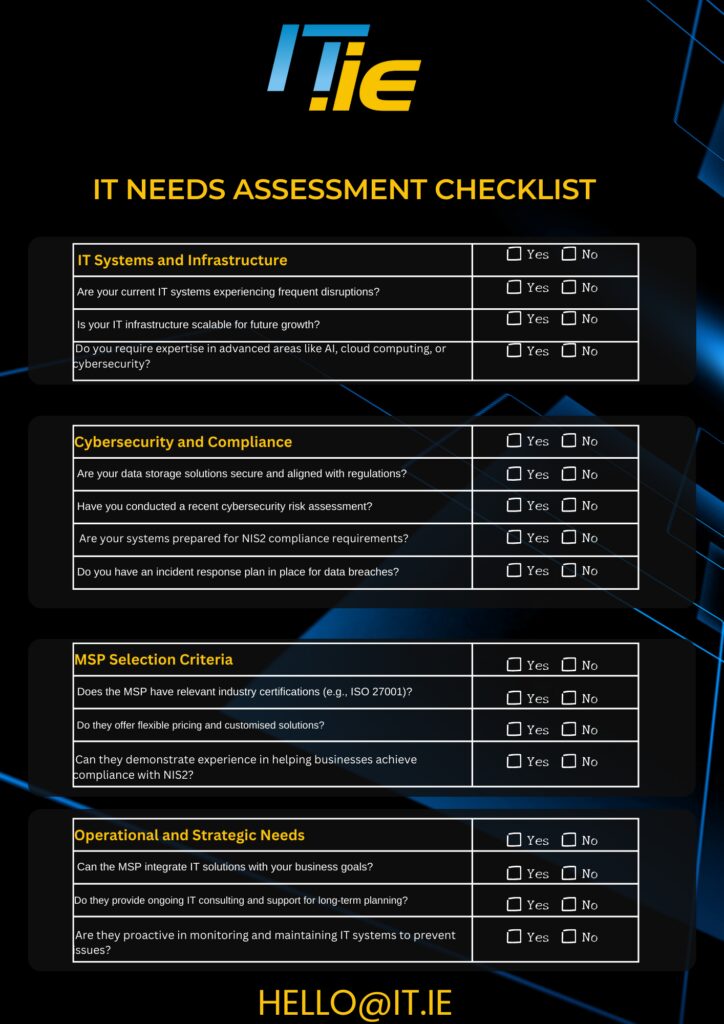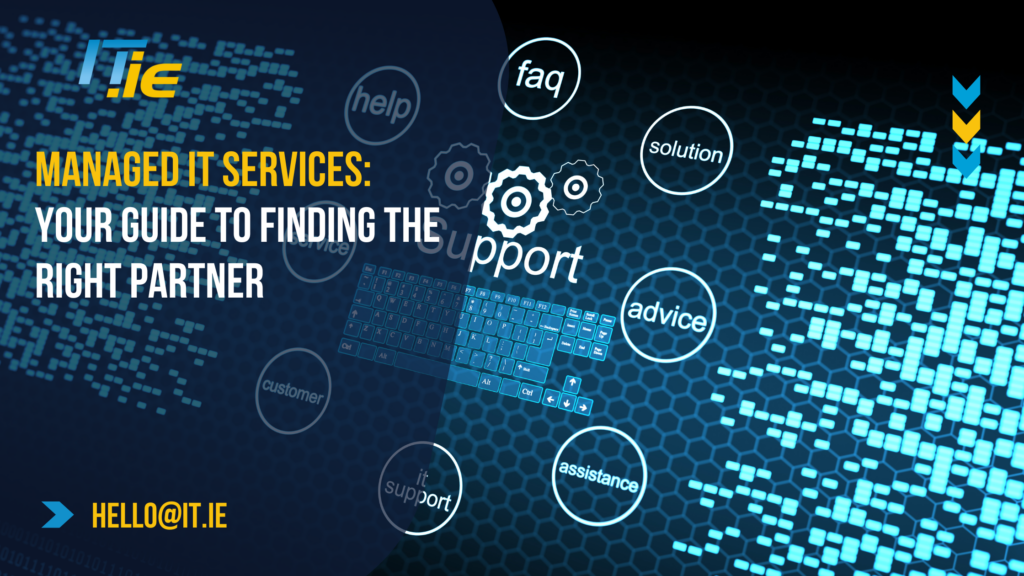Introduction
In today’s fast-paced business environment, technology is no longer just a support function—it is the backbone of successful operations. Managed IT Services Providers (MSPs) are key partners in helping businesses navigate complex IT landscapes, ensuring systems are efficient, secure, and aligned with business goals.
This guide provides a roadmap for identifying, evaluating, and partnering with the right MSP, empowering you to make informed decisions and achieve your organisational objectives.
What Are Managed IT Services?
Definition and Scope
Managed IT services involve delegating IT responsibilities to a professional third-party organisation. These services typically include:
- Proactive monitoring and maintenance.
- IT Support
- Security management.
- Backup and disaster recovery.
- IT consulting and strategic planning.
Benefits of Managed IT Services
- Proactive Problem Solving: Issues are identified and resolved before they disrupt operations.
- Cost Savings: Outsourcing IT reduces the need for full-time staff and expensive infrastructure.
- Access to Expertise: MSPs bring specialised knowledge across various technologies. It also gives you access to the resources and expertise previously only available to large organisations and multi-nationals.
- Enhanced Security: Dedicated teams ensure data protection and regulatory compliance.
Types of MSP Models
- Full-Service MSPs: Cover all aspects of IT, acting as an outsourced IT department.
- Co-Managed Services: Collaborate with in-house teams, filling gaps in expertise or capacity.
- Specialist MSPs: Focus on specific areas like cybersecurity or cloud services.
Understanding the Role of an MSP in Modern Businesses
Technology is evolving rapidly, and businesses must adapt to remain competitive. MSPs play a crucial role in:
Scalability
- Allowing businesses to grow without worrying about IT limitations.
- Offering scalable solutions, such as expanding cloud storage or increasing cybersecurity measures to adapt to the dynamic threat landscape.
Regulatory Compliance
- Assisting with NIS2, DORA, ISO standards, and other regulations.
- Reducing the risk of penalties through regular audits and secure systems.
Strategic IT Planning
- Providing insights into emerging technologies.
- Helping businesses align IT strategies with long-term goals.
Example: A small financial services company partnered with an MSP to overhaul its cybersecurity framework, ensuring full compliance with NIS2 regulations and improving client data security.
Identifying Your IT Needs
Conducting an IT Audit
- Map out existing systems, tools, and software.
- Identify recurring issues, such as downtime or slow performance.
- Assess compliance gaps and risks, particularly in light of new regulations such as NIS2 or DORA. requirements.
Setting Goals
- Define what you want to achieve with IT support (e.g., reduce costs, improve security, boost productivity).
- Categorise needs into immediate priorities and long-term objectives.
IT Needs Assessment Checklist

Evaluating Potential MSPs
Selecting the right MSP requires careful evaluation to ensure they align with your business needs and goals. This chapter outlines the critical criteria for assessing MSPs and provides guidance on identifying red flags to avoid potential pitfalls.
Key Criteria
- Expertise
- Look for industry certifications such as ISO 27001 and leading vendor partner certifications.
- Assess their experience with businesses in your industry.
- Service Offerings
- Ensure the MSP provides services essential to your operations, such as cybersecurity, cloud solutions, data protection etc.
- Flexibility
- Confirm they offer support tailored to your business requirements.
- Reputation
- Check online reviews, client testimonials, and case studies.
- Security Protocols
- Assess their approach to cybersecurity, including encryption, monitoring, and incident response.
Red Flags
- Lack of transparent pricing.
- Generic solutions with no room for customisation.
- Poor communication or delayed responses during initial interactions.
Questions to Ask an MSP
Choosing the right MSP is a critical decision for your business. Asking targeted questions ensures you select a provider that aligns with your operational needs and long-term goals. Focus on these key areas during discussions:
Customisation and Expertise
- How do you tailor your services to businesses in our industry?
- What experience do you have with companies of our size?
Onboarding and Integration
- What steps do you take to onboard new clients with minimal disruption?
- How do you integrate with existing IT infrastructure?
Cybersecurity and Compliance
- How do you ensure compliance with regulations like NIS2?
- What’s your approach to preventing and responding to data breaches?
Pro Tip: Ask for a live demo of their monitoring tools or a walkthrough of their incident response process. This will give you insight into their operational capabilities and customer focus.
Thoroughly addressing these questions will help you identify an MSP capable of delivering reliable, scalable, and secure IT solutions.
Subscription Model: IT as a Utility
Modern businesses increasingly view IT services through the lens of a subscription model, similar to utilities like gas or electricity. Just as you rely on your electricity provider to deliver consistent and reliable power, your MSP ensures your IT infrastructure is always operational and aligned with your business needs.
Predictable Costs:
Like a utility bill, the subscription model involves a fixed, recurring fee that covers essential IT services. This predictability allows businesses to budget effectively without worrying about surprise expenses.
Scalability:
The subscription model adapts to your business needs. As you grow, your IT services scale seamlessly, ensuring you always have the capacity and resources you need.
Reliability:
MSPs operating on a subscription basis ensure continuous service. Proactive monitoring and maintenance prevent disruptions, much like a utility company works to keep your power supply uninterrupted.
Benefits of IT as a Utility
- Focus on Core Operations: With IT treated as a utility, businesses can focus on their core functions, confident that their IT infrastructure is being managed efficiently.
- Access to Expertise: The subscription model ensures access to a dedicated team of IT professionals without the need for in-house staff.
- Compliance and Security: Your MSP ensures adherence to evolving regulations like NIS2, giving you peace of mind.
Building a Collaborative Partnership
Building a strong partnership with your MSP is essential for maximising the benefits of managed IT services. By establishing clear expectations, maintaining open communication, and committing to regular reviews, you ensure that your IT needs are met efficiently and effectively.
Defining SLAs
A Service Level Agreement (SLA) serves as the foundation of your partnership. It clearly defines:
- Response Times: How quickly the MSP addresses issues, ranging from critical outages to minor updates.
- Performance Metrics: Agreed benchmarks for system uptime, data recovery, and security measures.
- Responsibilities: Specific tasks and obligations for both the MSP and your organisation to avoid ambiguity.
An SLA is not static; it should evolve with your business needs and technology advancements.
Regular Reviews
Quarterly or biannual reviews are critical for assessing the effectiveness of the MSP relationship. These sessions provide an opportunity to:
- Evaluate the MSP’s performance against SLA metrics.
- Discuss updates to your business goals or IT needs.
- Address any concerns or areas for improvement.
Proactively scheduling these reviews fosters accountability and ensures alignment.
Open Communication
Strong communication is at the heart of any successful partnership. Treat your MSP as an extension of your team by:
- Establishing Clear Channels: Use designated communication platforms or contact points to streamline issue reporting and updates.
- Encouraging Transparency: Expect honest feedback and provide the same in return to build trust.
- Collaborating on Strategies: Include the MSP in your planning sessions to ensure IT initiatives align with your organisational goals.
By prioritising collaboration and mutual understanding, your partnership with the MSP will not only support day-to-day IT operations but also contribute to your long-term success.
Common Challenges and How to Avoid Them
Collaborating with an MSP can present challenges, but understanding these potential pitfalls allows you to address them proactively. By setting clear expectations and choosing the right partner, you can minimise risks and maximise the value of your MSP relationship.
Challenge 1: Misaligned Expectations
Misaligned expectations between you and your MSP can lead to frustration and unmet goals. For instance, unclear objectives or vague service descriptions in the SLA can create confusion.
Solution: Set clear goals and document them in the SLA. Ensure both parties agree on the scope of services, deliverables, and performance metrics.
Challenge 2: Limited Understanding of Your Industry
Some MSPs may lack experience in your specific industry, which can hinder their ability to provide tailored solutions or meet regulatory requirements.
Solution: Choose an MSP with proven experience in your sector. Request references to verify their expertise.
Challenge 3: Security Breaches
Cybersecurity is an ever-growing concern for businesses, and even the best-managed systems are not immune to attacks. A reactive approach to security can result in costly breaches and data loss.
Solution: Ensure the MSP conducts regular security audits and uses proactive monitoring. Verify their incident response plan and ensure they are prepared to mitigate risks promptly.
Conclusion
Choosing the right Managed IT Services Provider (MSP) is not just a practical decision but a strategic one that can transform your business operations. The right MSP can empower your organisation with streamlined IT processes, enhanced security, and the agility to adapt to changing market conditions and regulatory requirements.
Why This Decision Matters
An MSP partnership impacts every aspect of your business, from day-to-day operations to long-term growth. By entrusting your IT needs to a reliable provider, you gain:
- Operational Efficiency: A robust IT infrastructure reduces downtime and ensures seamless workflows.
- Scalable Solutions: MSPs can adapt to your evolving needs, enabling growth without IT bottlenecks.
- Regulatory Compliance: Expertise in navigating frameworks like NIS2 ensures your business avoids costly penalties and remains secure.
Steps to Success
To maximise the benefits of your MSP relationship, consider these final steps:
- Define Your IT Needs: Clearly outline your current challenges and future objectives.
- Thoroughly Evaluate Providers: Use the criteria and questions outlined in this guide to assess MSPs.
- Foster Collaboration: Treat your MSP as a strategic partner, ensuring regular communication and shared goals.
Next Steps
Download the PDF version of this guide and IT Needs Assessment Checklist or schedule a free consultation with us to explore how our managed IT services can drive your business forward. Let us help you transform your IT into a competitive advantage. Contact our experts today at hello@it.ie



